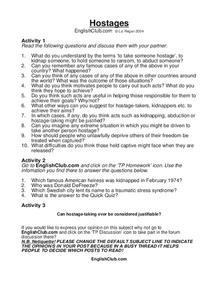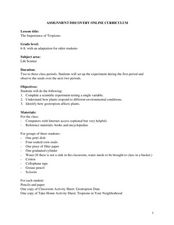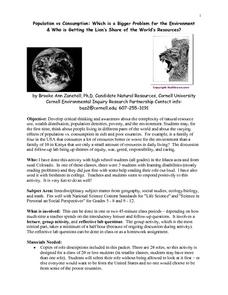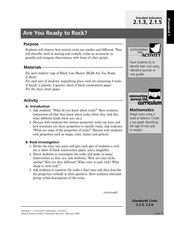Curated OER
Hostages
In this hostages worksheet, students, with a partner, read, analyze and discuss ten questions regarding terminology associated with someone taking someone else hostage.
Curated OER
Time and Timetables
In this recognizing time and timetables worksheet, learners compare Julian and Gregorian calendars, determine leap years, and apply the formula for finding the day of week and Easter day for any year. Students solve 20 problems.
Curated OER
The Importance of Tropisms
Students investigate plant tropisms using the scientific method. In this life science lesson, students learn about tropisms and test the response of corn seedlings to gravity. Response questions, extensions, and an adaptation for older...
Curated OER
Plant Pollination
Students investigate methods of pollination for various flowers. In this plant biology lesson plan, students learn the parts of a flower and form a hypothesis about the method of pollination for the flower. They determine the validity of...
Curated OER
Riddles Rule
Fourth graders examine words with multiple meanings. In this homonym lesson plan, 4th graders identify words that sound the same and define their meanings. Students create riddles using the homonyms they have learned.
Curated OER
The Three Little Pigs' Straw House
Second graders design and sketch a model house. In this technology lesson, 2nd graders construct their house using teacher provided materials. They present their finished project and explain their design in class.
Curated OER
Bouncing off the Walls
Third graders compare the bouncing height of different types of balls. In this science lesson, 3rd graders explain the importance of repeated experimentation in science. They record their result and share them with the class.
Curated OER
Inventing Inventions
Students identify how inventions can be used in different ways. In this inventions lesson students brainstorm different uses as a group and fill out a worksheet.
Curated OER
Gone But Not Forgotten
Third graders examine animals and organisms that have become extinct and their similarities to living organisms. In this extinction lesson plan students divide into groups and research extinct animals.
Curated OER
Climate Change
Students focus on the production of maple syrup in Northern New England as they study the effects of climate change. They investigate other environmental factors on the forests of Northern New England.
Curated OER
When My Name Was Keoko
Learners construct a book banquet to help us to recall and enjoy food eaten in Korea during the 1940's. The class is to read When My Name Was Keoko and then create a book banquet that the students invite their parents to. Learners cook...
Curated OER
Asthma and Allergies
Students show the symptoms of asthma, diabetes and common allergies. Students discuss ways of managing asthma, diabetes and allergies. Students devise ways of helping children to cope with these.
Curated OER
Dealing With Anger
Students assess their own anger levels over the past 12 months. Students discuss when it occurs and ways of dealing with it. Students design a questionnaire to measure young people's anger.
Curated OER
Design and Construction of an Eco-House
Students are able to design, construct, evaluate and recommend materials for planned Eco-house to be built on campus. They investigate about good design and plan for construction. Students have a greater knowledge and appreciation of...
Curated OER
Population Vs Consumption: Which is a Bigger Problem for the Environment & Who is Getting the Lion's Share of the World's Resources?
Students develop critical thinking and awareness about the complexity of natural resource use, wealth distribution, population densities, poverty, and the environment. They think about people living in different parts of the world and...
Curated OER
Systems of Equations in Space Science
In this system of equations worksheet, students solve 2 problems by creating a system of equations for each problem in order to determine the average intensity of flares from the sun and the average power from a satellite transponder.
Curated OER
Difference of Squares
Students analyze arithmetic statements. For this difference of squares lesson, students explore patterns and factor the difference of two squares. They compare quantities with integers. Students model and solve equations.
Curated OER
The Journey to Civil Rights
Students explore Civil Rights. In this Civil Rights lesson, students read about Ruby Bridges and define the words segregation and supremacy. Students make a timeline of important events in Civil Rights and write a paragraph about why the...
Curated OER
Should US Officials & Health Professionals be Investigated for War Crimes?
Students explore ethical issues. In this human rights lesson, students read articles and documents related to torture used in government investigations and if medical ethical guidelines were adhered to. Students respond to discussion...
Curated OER
Local Leaders
Second graders recognize the importance of having community leaders. In this community leaders lesson, 2nd graders find local leader names and local leader news items. Students answer questions and create a graphic organizer about a...
Curated OER
Searching For Letters, Words, and Sentences
This simple lesson plan is designed for K - 1 students. They are introduced to individual letters, words, and sentences. A game is played where they try to collect one example of each. For practice, students complete a worksheet which is...
Curated OER
Outline It!
Fourth graders investigate how outlining can aid in comprehending text. In this reading comprehension lesson, 4th graders outline an article they read in groups of two. Students take turns reading the article, identifying the main idea,...
Curated OER
What About Cantaloupes?
Second graders investigate the physical properties of cantaloupe using their senses. In this life science activity, 2nd graders estimate the weight of their sample. They get it's actual weight and compare it with their estimate.
Curated OER
Are You Ready to Rock?
Second graders investigate rock samples using magnifying class. In this earth science lesson, 2nd graders identify the physical properties and describe them verbally with their partners. They compare their findings with the class.

























